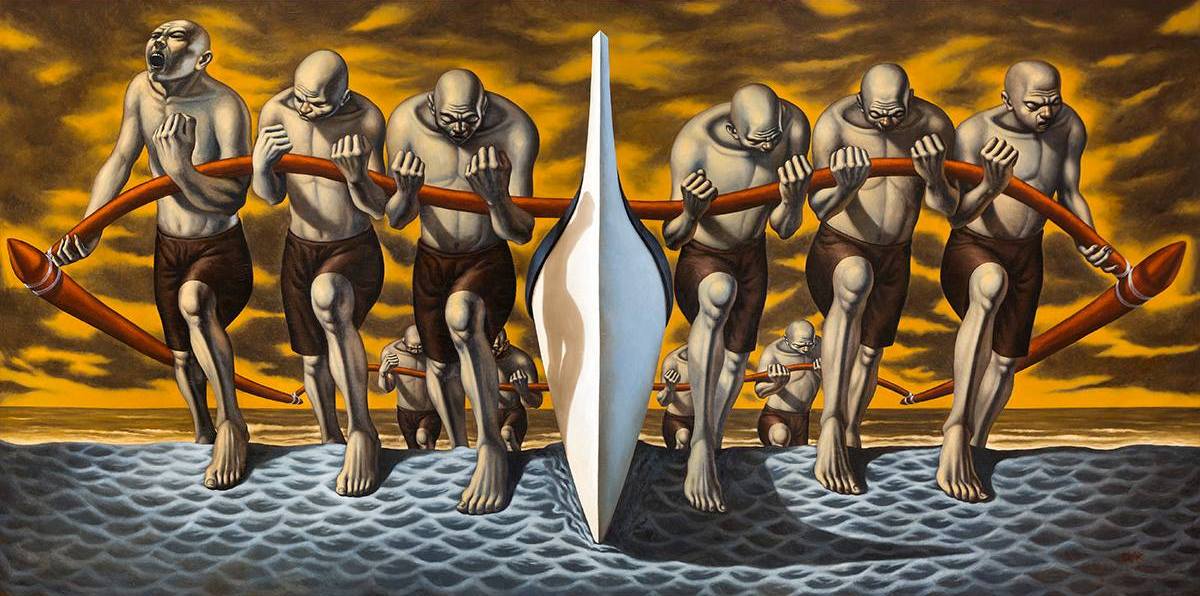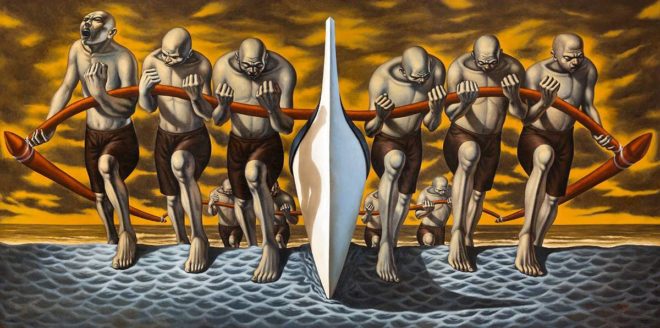
Just across the street from Elmer Borlongan’s childhood home on 9 de Febrero Street in Mandaluyong is the National Mental Hospital.
When they were children, he and his playmates would climb over the walls to play in the vegetable patches that the inmates tended as part of their therapy, and presumably to supplement their hospital diets.
During the day, the more “stable” among the recovering mental patients, still wearing their blue hospital smocks, would be let out to work at odd jobs in the neighborhood, returning to their hospital beds at night.
Longtime residents like the Borlongans saw nothing odd or unusual about this. But it must have made an impression on Elmer, because many years later, shaven-headed figures with intense, brooding expressions started appearing in his paintings.
“I guess they came out subconsciously,” the painter surmises. “My subject matter is based on first-hand experience and my environment.”
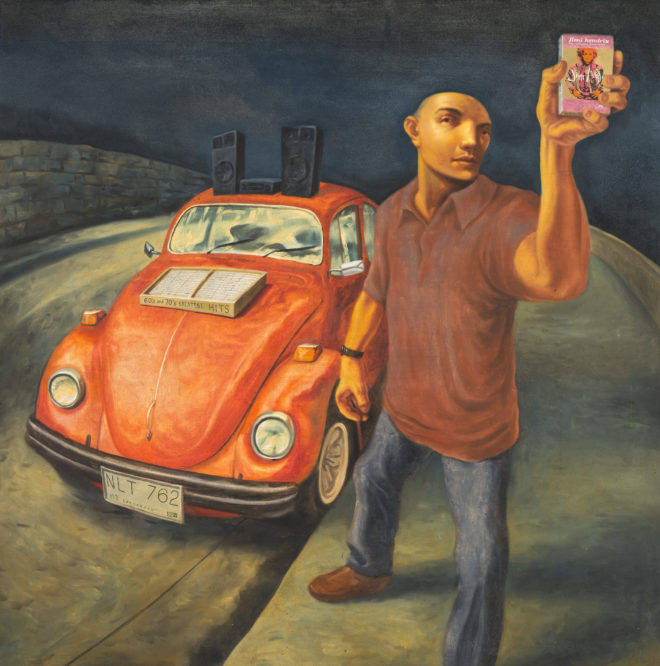
Peculiar knack
Every artist interprets the world through the prism of his or her own experiences, but Borlongan has a peculiar knack for digging out these subconscious resonances in scenes of everyday life. Whether inhabiting a sunlit rural scene or lurking in the shadows of the city, his characters—who are more often than not inspired by real people—go about their everyday lives as if nothing unusual is going on.
But beneath the veneer of ordinariness is a sense that there’s something more beneath the surface, a deeper reality just beyond the threshold of awareness that keeps the viewer intrigued and engaged.
Painted in his signature style that is often described as “figurative expressionism,” his works offer a unique perspective on modern Philippine life, making him one of the most acclaimed and accessible Filipino artists of his generation, as well as one of the most sought-after by galleries and collectors.
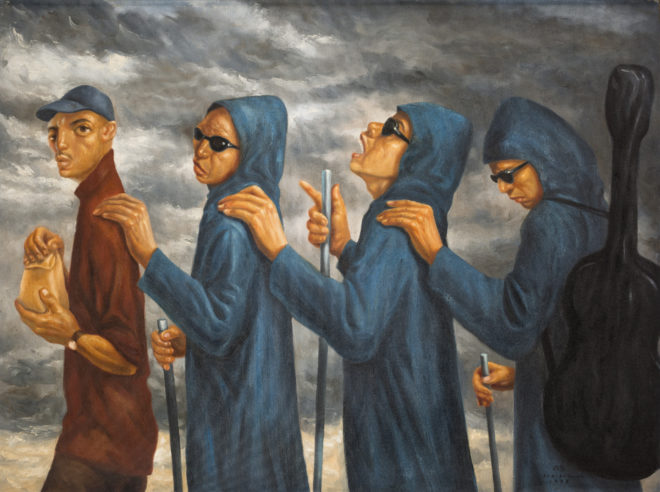
Survey show
Now is probably as good a time as any to assess Borlongan’s place in contemporary Philippine art, hence “Elmer Borlongan: An Extraordinary Eye for the Ordinary,” a look back at a quarter century of the artist’s professional life.
“I don’t want to call it a retrospective,” says Borlongan, who at 51 feels he’s just hitting his stride as a painter. “Let’s just call it a survey show.”
Curated by historian and art connoisseur Dr. Ambeth Ocampo, the exhibit opened Jan. 20 at Metropolitan Museum of Manila. It collects in one space over a hundred paintings and more than 50 drawings, including some juvenilia dating back to Borlongan’s early art studies under Fernando Sena.
By sheer scale alone, it matches some of the more exciting retrospectives held recently: Danny Dalena’s at the Cultural Center of the Philippines last year, and Bencab’s 50-year retrospective at the Metropolitan two years prior. Few would argue that Borlongan belongs in their august company—or will soon enough.
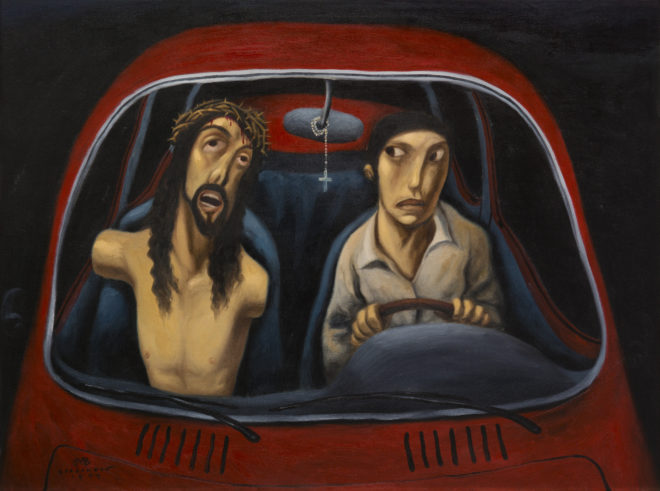
Overwhelming
“I never imagined that I would be having a solo show at the Metropolitan,” he says with characteristic modesty.
Many years back, he recalls, he and his wife Plet Bolipata went to see the Ang Kiukok retrospective in the same gallery. They had seen only half the works on exhibit when they looked at each other and spontaneously decided to go home to paint.
“It was that overwhelming,” he says. “Hopefully, this show can have the same effect on younger artists.”
Borlongan now divides his time between San Antonio, Zambales, where he and his wife moved 14 years ago, to get away from the hectic local art scene so they could focus their energies on the creative process, and their home/studio in a quiet Marikina suburb where they stay when they need to attend to exhibits and other projects.
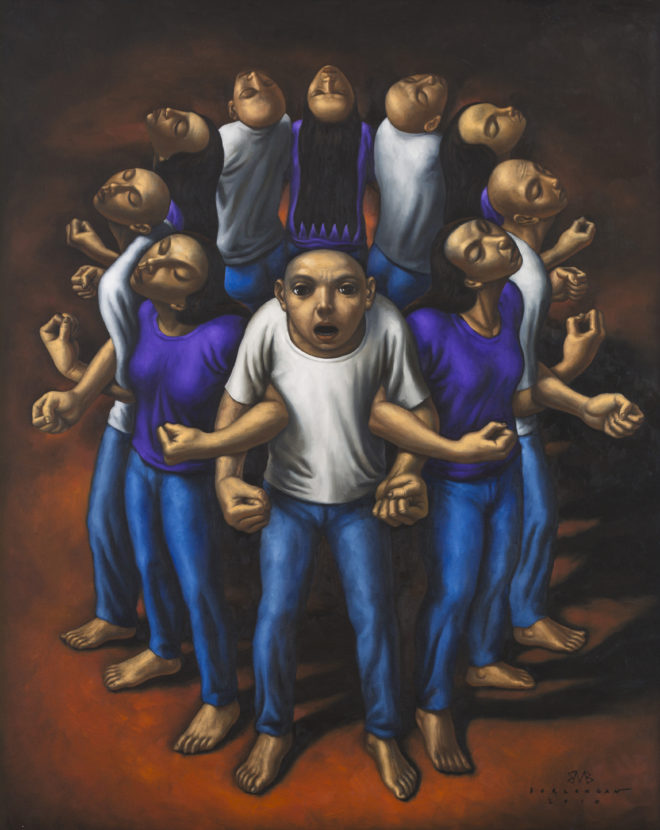
‘Painter’ than ‘artist’
One of the threads that runs through all of Borlongan’s work is his preoccupation with technique. He self-identifies more as “painter” than “artist,” and it is the physical act of painting, laying pigment on canvas, that seems to give him the most satisfaction.
Although his sensibility is completely modern, Borlongan’s technique is grounded in the principles of classical painting: line and color, light and shade. He is steeped in the works of the masters, from El Greco and Rembrandt to Botong Francisco and Victorio Edades, and counts an epiphanal viewing of Theodore Gericault’s “Raft of the Medusa” at the Louvre as one of the turning points in his art.
Redolent with the scent of linseed oil, Borlongan’s sunlit studio is a place of daily worship, where by dint of strenuous practice, the artist imposes order and meaning on an otherwise chaotic world.
“As a full-time painter, I’ve disciplined myself to paint as if I was keeping regular office hours,” he says. “After breakfast, I work continuously from 8 a.m. onward. I take a break for lunch and a little siesta, then it’s back to work until the light fades.”
Natural light
Borlongan doesn’t paint at night because he prefers to work by natural light, but he likes to listen to music while he works, mostly classic rock or the new wave records that he cut his teeth on while he was an art student at the University of the Philippines and playing in the hardcore punk band Is It Safe?
“My habit is to draw every day,” he adds. “It helps because when I face the canvas in my studio, I seldom draw a blank. I go back to my sketchbooks, find notes and references and a few scribbles and ideas that I can develop further into a finished work.”
Working from drawings, he will make preliminary studies on paper with watercolor or pastel before doing the final work in oil on canvas, or sometimes with acrylic paint. It typically takes him four days to a week to finish a large 4’ x 4’ painting, he says.
“It’s tactile,” he says. “I like to feel the plasticity of the material, the smoothness or the roughness of the paint. If feels good.”
As far as subject matter is concerned, Borlongan’s evolving work-in-progress is a portrait of the Filipino as human being. These keenly observed slices of life have been at the heart of his ouvre since he abandoned his earlier, ideologically-based socialist realism in favor of a more personal exploration of modern life and its discontents as filtered through the artist’s own life experiences.
“Consciously, I look for something new in terms of content, because when it comes to form, I feel I’ve exhausted all the art styles, techniques and approaches to painting,” he says.
“I may have adopted one style but I keep looking for subjects that I have not yet represented in a painting.”
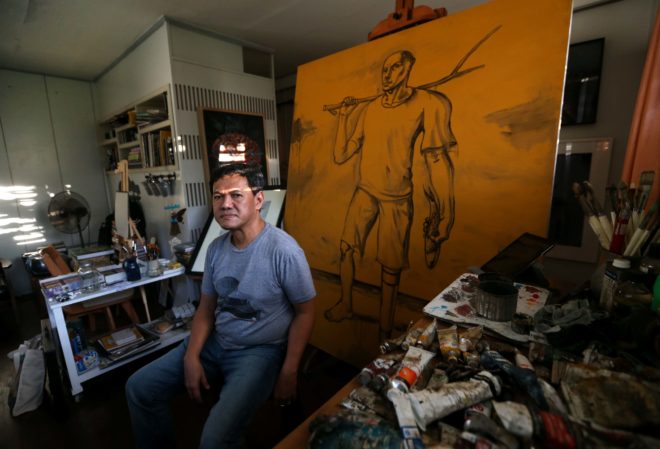
Tutelage
Borlongan’s artistic bent was encouraged early on by his father, a chemist, and his mother, a pharmacist. An aunt referred him to Fernando Sena, a painter and art educator whose own work was influenced by the impressionists and the cubists, and Borlongan entered his tutelage when he was still in the sixth grade.
“I was able to draw realistically and paint from memory,” he recalls. “Botong Francisco was my favorite so I tried to copy his style. I thought that was what an artist was supposed to do.”
By the time he began formal art studies at the University of the Philippines College of Fine Arts in the mid-1980s, however, nobody seemed to know what an artist was supposed to do—Borlongan least of all.
Thanks to Roberto Chabet’s considerable influence, conceptual art was all the rage at UP. Meanwhile, New York art stars such as Jean-Michel Basquiat and Keith Haring were hailed as the new culture heroes. Botong Francisco seemed very old hat, indeed.
Art for the people
Borlongan’s solution was to join a hardcore punk band started by some of his classmates called Is It Safe? (from Laurence Olivier’s famous line in “Marathon Man”). Apart from gigs in UP, Is It Safe? managed to play gigs in Katrina’s, a Pasay City dive that was the local punk rock mecca at the time.
Despite these distractions, Borlongan managed to further polish his technique, which had always been his strong suit. His teachers and classmates recognized that he had something.
In his third year, he and classmate Mark Justiniani joined Artista ng Bayan (Abay), an activist art collective that served as the graphics department for various leftist nongovernment organizations. They were kept busy churning out visual aids, posters, leaflets, banners and effigies for orientations and rallies. So busy were they that Borlongan eventually decided to drop out of art school after they got more involved in the movement.
So enamored were they with the idea of “art for the people” that they stopped going to galleries and attending openings, turning their backs on the art “establishment.”
After a couple of years, however, the rigid formulas of socialist realism, with its heroic peasants, workers and students and craven capitalists and military started to feel constricting, and he and his friends started looking for a more organic, individual expression.
They found it in the Salingpusa group, a loose collective of artists that gravitated around Dr. Joven Cuanang’s Antipolo home and his Boston Gallery in Cubao, where Borlongan held his first one-man show in 1993.
Validation
People started to take notice of his work. He was elated when he managed to sell four out of eight paintings in his second one-man show “God Bless Our Trip”—all the more since one of the buyers was none other than Bencab.
“I was overjoyed,” he recalls. “An artist that I looked up to had bought one of my works. It felt like validation. Maybe I was doing the right thing, and I should continue.”
Further validation came when he received the Cultural Center of the Philippines’ prestigious Thirteen Artists Award for 1994. The following year, while serving as artist-in-residence at Casa San Miguel in San Antonio, Zambales, he met fellow artist Plet Bolipata, whom he married in 1998. After five years, the couple decided to make their home in Zambales.
It was a sea change, quite literally.
Since Borlongan drew inspiration from his observations of daily life and his environment, his earlier paintings were set in gritty, tropical noir cityscapes, his characters swathed in shadows cast by concrete buildings and narrow alleyways. His palette was dominated by blacks and greys and earth tones, with just a hint of red and blue.
After Zambales, where he was exposed to life in a rural fishing village, his palette expanded to include greens and purples, and the blues became more dominant as sunlight replaced shadow.
Borlongan’s rural scenes are anything but pastoral, however. Despite their subject matter, there is still that suggestion of something deeper just beneath the surface. He is currently working on a large portrait of a fisherman, gazing out at the viewer from the shore, fish in hand and a pole slung casually over one shoulder. One’s eye is immediately drawn to the fisherman’s peg leg. A Filipino Ahab brooding on his “white whale”? Missing limbs are an all-too-common sight in fishing villages where illegal dynamite fishing persists, the artist explains.
“Elmer Borlongan: An Extraordinary Eye for the Ordinary,” opens Jan. 20, at Metropolitan Museum of Manila, Bangko Sentral ng Pilipinas Complex, Manila.

